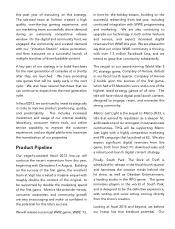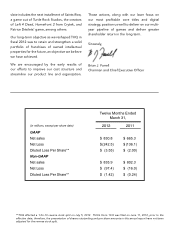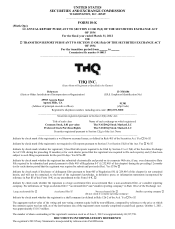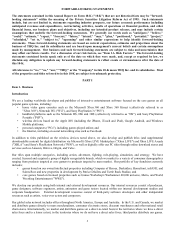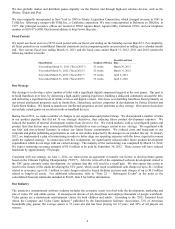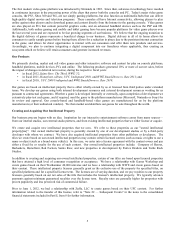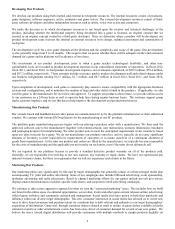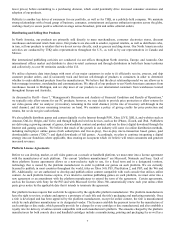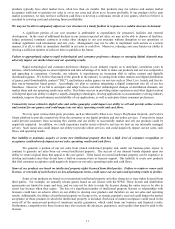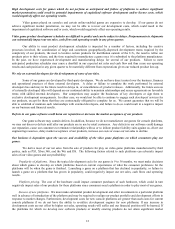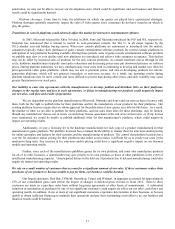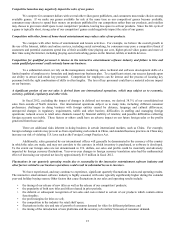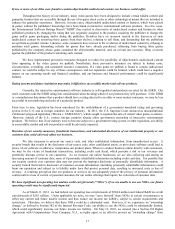THQ 2012 Annual Report Download - page 15
Download and view the complete annual report
Please find page 15 of the 2012 THQ annual report below. You can navigate through the pages in the report by either clicking on the pages listed below, or by using the keyword search tool below to find specific information within the annual report.7
lower prices) before committing to a purchasing decision, which could potentially drive increased consumer awareness and
adoption of our products.
Publicity is another key driver of awareness for our portfolio, as well as for THQ, as a publicly-held company. We maintain
strong relationships with a broad group of business, consumer, entertainment and games enthusiast reporters across the globe,
working closely to secure positive editorial coverage across broadcast, print and online editorial outlets.
Distributing and Selling Our Products
In North America, our products are primarily sold directly to mass merchandisers, consumer electronics stores, discount
warehouses and national retail chain stores. Our products are also sold to smaller, regional retailers, as well as distributors who,
in turn, sell our products to retailers that we do not service directly, such as grocery and drug stores. Our North American sales
activities are conducted by THQ sales representatives throughout the U.S., as well as by our representatives in Canada and
Mexico.
Our international publishing activities are conducted via our offices throughout North America, Europe, and Australia. Our
international offices market and distribute to direct-to-retail customers and through distributors in both their home territories
and collectively, to over 80 territories outside of the U.S.
We utilize electronic data interchange with most of our major customers in order to (i) efficiently receive, process, and ship
customer product orders, and (ii) accurately track and forecast sell-through of products to consumers in order to determine
whether to order additional products from the manufacturers. We believe that the direct relationship model we use allows us to
better manage inventory, merchandise and communications. We ship all of our products to our North American customers from
warehouses located in Michigan, and we ship most of our products to our international customers from warehouses located
throughout Europe and Australia.
As discussed in Part II—Item 7, "Management's Discussion and Analysis of Financial Condition and Results of Operations,"
we typically only allow returns for our PC products; however, we may decide to provide price protection or allow returns for
our video games after we analyze: (i) inventory remaining in the retail channel, (ii) the rate of inventory sell-through in the
retail channel, and (iii) our remaining inventory on hand. We maintain a policy of giving credits for price protection and
returns, but we do not give cash refunds.
We also globally distribute games and content digitally via the Internet through PSN, Xbox LIVE, XBLA, and websites such as
Amazon, OnLive, Origin, and Valve, and through high-end wireless devices, such as the iPhone, iTouch, and iPad. Publishers
are delivering a growing amount of games, downloadable content and product add-ons by direct digital download through the
Internet and gaming consoles. We believe that much of the growth in our industry will come via online distribution methods,
including multi-player online games (both subscription and free-to-play), free-to-play micro-transaction based games, paid
downloadable content ("DLC") and digital downloads of full games. Accordingly, we plan to continue integrating a digital
strategy into our franchises where applicable, thus creating an ecosystem which we believe will retain consumers and generate
increased revenues.
Platform License Agreements
Before we can develop, market, or sell video games on a console or handheld platform, we must enter into a license agreement
with the manufacturer of such platform. The current "platform manufacturers" are Microsoft, Nintendo and Sony. Each of
these platform license agreements allows us a non-exclusive right to use, for a fixed term and in a designated territory,
technology that is owned by the platform manufacturer in order to publish our games on such platform. We are currently
licensed to publish, in most countries throughout the world, titles on Xbox 360; PS3, PlayStation 2, and PSP; and the Wii and
DS. Additionally, we are authorized to develop and publish online content compatible with each console that utilizes online
content. As each platform license expires, if we intend to continue publishing games on such platform, we must enter into a
new agreement or an amendment with the platform manufacturer to extend the term of the agreement. Certain agreements,
such as the licenses with Sony for the PS3 and with Microsoft for the Xbox 360, automatically renew each year unless either
party gives notice by the applicable date that it intends to terminate the agreement.
Our platform licenses require that each title be approved by the applicable platform manufacturer. The platform manufacturers
have the right to review, evaluate and approve a prototype of each title and the title's packaging and marketing materials. Once
a title is developed and has been approved by the platform manufacturer, except for online content, the title is manufactured
solely by such platform manufacturer or its designated vendor. The licenses establish the payment terms for the manufacture of
each cartridge or disc made, which generally provide for a charge for every cartridge or disc manufactured, and also establish a
royalty rate for delivery of online content compatible with such manufacturer's platform. The amounts charged by the platform
manufacturers for both console discs and handheld cartridges include a manufacturing, printing and packaging fee as well as a


